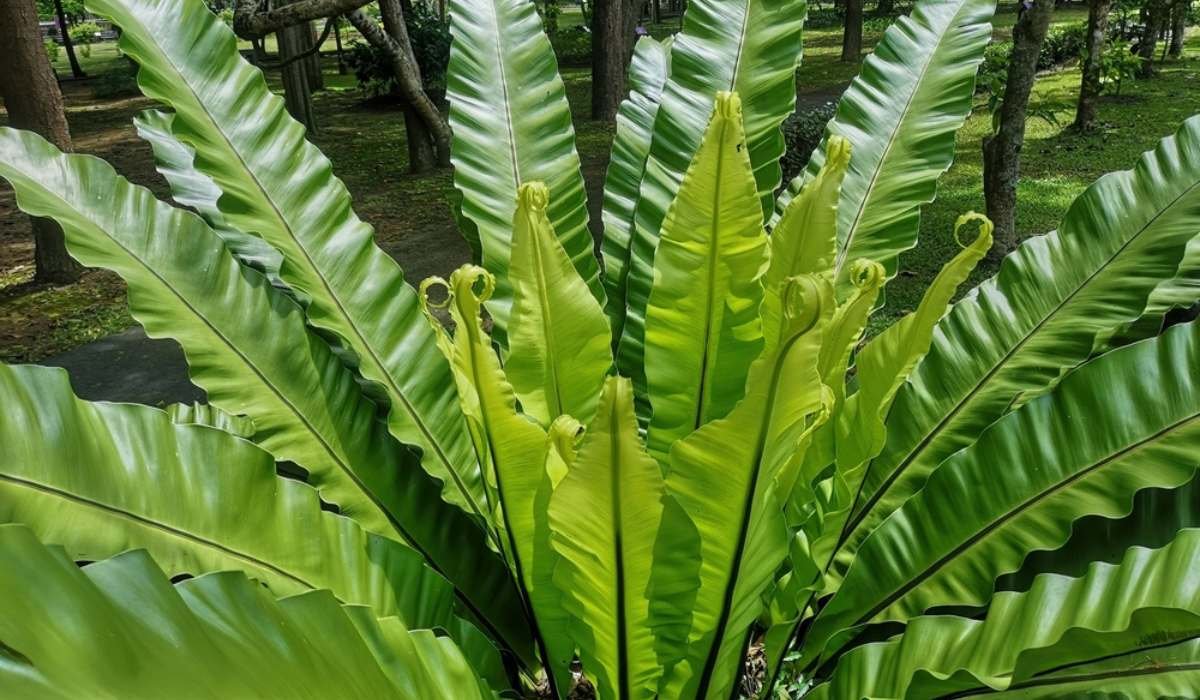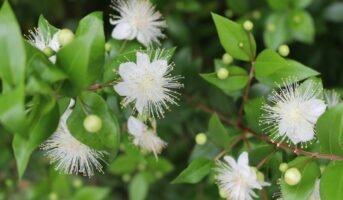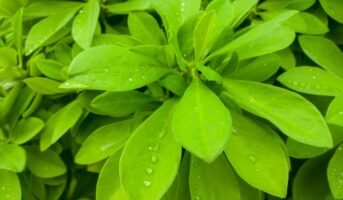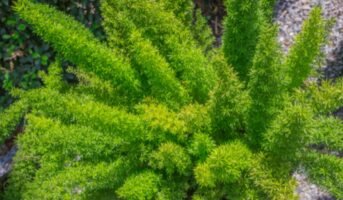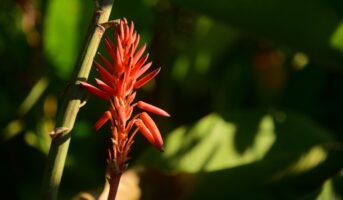Bird’s Nest fern (Asplenium nidus) is a tropical, slow-growing, evergreen, perennial houseplant with glossy, attractive leaves and can live happily in many homes with only a little care. Native to tropical regions such as southeast Asia, Australia, east Africa, and Hawaii, given the right indoor environment, it will thrive and make for a wonderfully unique houseplant. It is distinguished by dramatic foliage that resembles banana leaves.
See also: Garden roses: Facts and tips to grow
Bird’s Nest fern: Key facts
| Common name | Bird’s Nest fern, Nest fern |
| Botanical name | Asplenium nidus |
| Family | Aspleniaceae |
| Plant type | Epiphyte, Fern, Perennial |
| Mature size | 3-5 ft. tall, 2-3 ft. wide |
| Sun exposure | Partial, shade |
| Soil type | Loamy, moist, well-drained |
| Flower | No flower |
| Native Area | Asia, Australia, Africa |
| Growth Rate | Slow |
| Maintenance | Medium |
| Leaf Description | Light green, glossy, simple, strap-shaped, and wavy with a brown-black midrib. Fronds can reach lengths of 4-5 feet and a width of 8 inches. |
See also: Mango: What makes India’s national fruit so special?
Bird’s Nest fern: Physical description
- The Bird’s Nest fern is an epiphytic fern that usually grows on other surfaces, of tree trunks or buildings.
- As the fronds of this plant turn brown, they roll back and form a giant leaf nest in the tree’s branches and trunk. The core of the plant bears a resemblance to a Bird’s Nest and is therefore called a Bird’s Nest plant.
- The fronds of outdoor plants can grow up to 4-5 feet long and 8 inches wide. Typically, the fronds of indoor houseplants are 1.5 to 2 feet long.
- This plant predominantly reproduces through spores and produces no flowers or fruit.
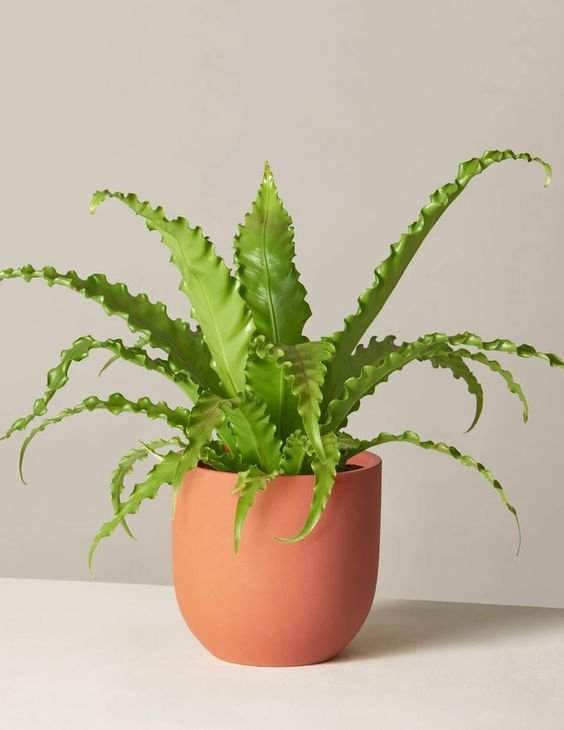
Source: Pinterest
See also about: Episcia Cupreata: All you need to about the house plant
Types of Bird’s Nest fern
-
Asplenium Antiquum ‘Victoria’
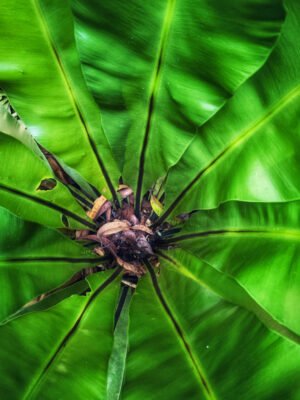
Asplenium Antiquum ‘Victoria’ is a native to tropical regions of Asia, Australia and the Pacific islands.
Leslie

The Leslie is a houseplant and can tolerate low to bright indirect light.
Crispy wave
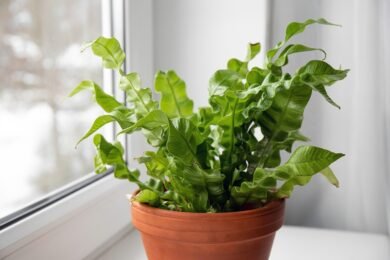
It is a popular houseplant as it is easy to care and can thrive in low to medium light conditions and tolerate dry air.
Crissie

This is easy to grow and maintain and grows to a height of 15-21 inches.
How to grow Bird’s Nest fern?
- It might be challenging to grow bird’s nest ferns, especially for newbie gardeners.
- Although buying nursery plants is a popular alternative, cultivating your own plants from seed is always the best choice for superlative quality.
- You can grow these plants from the seeds or from infant plants directly.
- For growing it from seeds of an existing plant, you can cut off a frond, collect the spores, and keep the frond in a paper bag for a few days. The bag will be filled with spores soon.
- After that, scatter the spores over some sphagnum moss that has been placed in a water dish so that they may absorb the water.
- Later, place the container in a warm, shaded area and cover it with plastic wrap to maintain a moist environment.
- Maintain a constant water level in the container and keep the moss moist to accelerate the germination process. The seeds should germinate in a few weeks and will be ready to be sown.
All about the common jasmine
Bird’s Nest fern: Care
- Bird’s Nest fern are easy to maintain and stay content with little care.
- They can survive in shallow pots and receive their nourishment and moisture from the air.
- The plant excels in soil rich in organic matter, damp and porous, like fern potting soil. Plants in containers do well in peat-based potting soil.
- A north-facing window or other well-lit and light-shade area are ideal if kept indoors. Direct sunlight could cause it to turn yellow or halt its growth; therefore, these plants shouldn’t be kept outside in direct sunlight. Ideal temperatures for healthy growth of this plant should be 60-70° F.
- Being an epiphyte plant, bird’s nest fern requires high humidity and moist soil. This plant cannot survive in dry conditions.
- It might be necessary to mist or humidify the area to achieve the right humidity level. Avoid watering the plant’s centre directly.
- Apply a diluted liquid fertilizer every month during the active growth season for a better growth rate. Be sure to apply the fertilizer to the soil and not the fronds, as direct contact with fertilizer can burn foliage. Avoid too much fertilizer, as it can cause the foliage to turn yellow.
- Adequate warmth, humidity, and moisture are required for better plant health. While it must also have access to light, one of the ideal locations to place a bird’s nest fern when growing it as a houseplant is in areas that will receive the right amount of warmth and humidity and also have access to light.
- The fresh and delicate fronds that are emerging from the center should not be handled in any way. They are very flimsy and can be easily broken or deformed when touched.
- Bird’s nest ferns are typically healthy plants, although they can be susceptible to a few problems that are primarily caused by an unsuitable environment. Therefore, the environment they are kept in should be checked thoroughly.
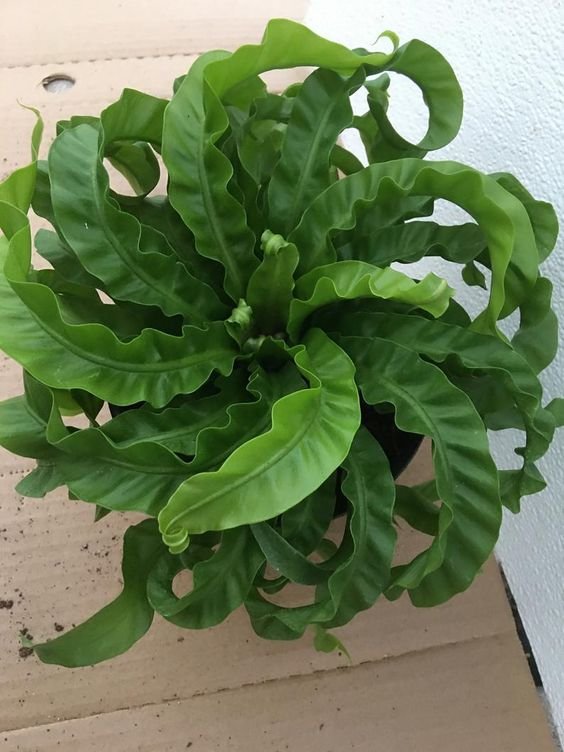
Source: Pinterest
see also about the common jasmine
Bird’s Nest fern: Uses
Food
- The native tribes of Malaysia occasionally consume Bird’s nest fern. Tender leaves of this plant are eaten stir-fried, boiled, or steamed.
- Bird’s nest ferns are nourishing and flaky, and any dish would be delighted by their lively green colour.
Medicinal
- The aboriginal tribes of Malaysia have used the Bird’s Nest fern for a variety of medical purposes.
- The fronds are infused to reduce labour pain.
- Additionally, the leaves can be mashed in water and applied topically to cure fever.
- Two juvenile fronds can be consumed when still coiled to serve as a contraceptive.
- Tea made from fronds can be consumed to treat general weakness.
Other uses
- The fern is cultivated as an ornamental and is valuable commercially.
- It can be planted outside for landscaping purposes.
- It is also a well-known houseplant in Singapore, as it’s affordable and easy to grow.

Source: Pinterest
Bird’s Nest fern: Is it toxic?
No toxic behaviour of this plant is recorded towards humans, cats, or dogs.
See also about: Indoor garden design
FAQs
Are bird's nest ferns hard to take care of?
Bird's nest ferns are generally healthy plants and do not require much care. Just the right environment and boom, they flourish.
Do bird's nest ferns cleanse the air?
Yes! They have incredibly effective air-purifying qualities.
Do bird's nest ferns like small pots?
They grow gradually, and smaller pots work better for them than very large ones. A large container may hinder the plant's ability to obtain water properly, leading to health problems.
| Got any questions or point of view on our article? We would love to hear from you. Write to our Editor-in-Chief Jhumur Ghosh at jhumur.ghosh1@housing.com |
Housing News Desk is the news desk of leading online real estate portal, Housing.com. Housing News Desk focuses on a variety of topics such as real estate laws, taxes, current news, property trends, home loans, rentals, décor, green homes, home improvement, etc. The main objective of the news desk, is to cover the real estate sector from the perspective of providing information that is useful to the end-user.
Facebook: https://www.facebook.com/housing.com/
Twitter: https://twitter.com/Housing
Email: editor@housing.com
